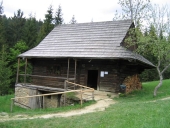i'm loving this. Was a Vaisnava for a little while on New Barsana in Western Colorado farm - and some of the best, most peaceful times in my life were my reading to the devotees as they ate lunch in the sun around the
root cellar on the farm. i've also done living history - was a 1700s woodworker and back-up blacksmith at a 1700s era refuge fort in the early 80s. Had my own shaving horse, broad axe, carpenter's adze (toe adze) etc. Split
enough shingles with a froe and riving knife to roof many squares of roof.
Your pitch is really steep in the drawing - looks to be about 14 or more - 16? Regardless - there is no need to plane the
wood - best would be a rough sawn cut and let the gravity do the work. When you plane you have more cell walls cut through. That makes them more susceptible to rot, molds, mildews, etc. Broken cell walls allow the exterior moisture in more easily and they expand more easily, contract more easily. The strongest would be splitting as almost all cells will remain intact. Next best would be a rough sawn shingle. Least desirable from the wood standpoint - and it adds extra time and processing - is the planing. If you nick your blades that shortens their lives too. i personally don't like wasting steel, and i have enough equipment left over from when i built million dollar houses in SW Colorado mountains that i own multiple sets of planer blades. And a sharpener for them. But i would not ever consider what you're talking about.
Before i did that, i'd rig up some sort of depth controlled v-groove maker that i pulled toward me. Think good high
carbon steel with a v-shape, a cross piece that would prevent the chisel tip digging in (being sawn - SOME of that wood grain will pull you up, some down and you may rip it deeper than you want if you aren't real careful to follow the grain in your shingle blanks, or you hit knotty or wild grain, or compression wood, or...)
Well, i'm loving it. Always been afraid to go to India because i'm afraid i'd never want to come back.
brad

 3
3








































 1
1









 1
1











